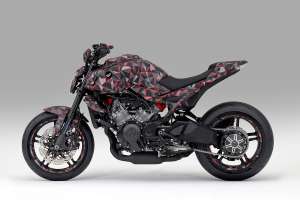
Honda V3R 900 E-Compressor
Last year at EICMA, Honda wowed audiences with a triple-cylinder engine sporting an electronically controlled compressor. This year, they confirmed the engine’s actual capacity—and finally teased a prototype that puts it to use. Which makes this possibly the motorcycle industry’s slowest model reveal.
Officially named the V3R 900 E-Compressor Prototype, Honda is pitching this as a precursor to a new production model, rather than a once-off experiment. Presented as a complete machine, the V3R is styled as a modern streetfighter with a handful of unique details—like asymmetrical side fairings, which have presumably been designed that way to optimize airflow for the compressor.

The engine itself is a 900 cc 75-degree V-triple, while Honda touts the electronically controlled compressor as a world-first for motorcycles. The idea is that the system allows more precise control over boost, delivering high torque at low revs and offering performance on par with bigger motors, in a slimmer package.
We’ll probably have to wait another year to see the final product, but in the meantime, color us excited. [Honda Europe]

Ducati DesertX
Since Ducati introduced its next-gen V2 engine last year, it’s gone on to power the Panigale, Multistrada, Streetfighter, and Monster. At EICMA, the Borgo Panigale marque gave us a sneak peek at the next model to adopt the new platform—the 2026 Ducati DesertX.
Ducati’s V2 motor made waves for its non-desmodromic intake variable valve timing system, smaller 890 cc capacity, and lower weight. It makes 120 hp and around 93 Nm of torque in the Panigale, but in the new DesertX, those numbers are capped at 110 hp and 92 Nm. That said, the DesertX is a hair lighter now, with a dry weight of 206 kilos [454 pounds].
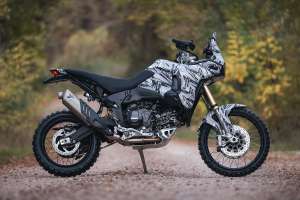
Ducati didn’t reveal much else about the DesertX at EICMA—other than that it has a new suspension setup with a progressive rear linkage. But the camo livery adorning the display bike did little to hide the fact that this is pretty much an all-new motorcycle. A host of updates are visible, including reshaped bodywork, a revised frame, and a new swingarm.
As for the rest, we’ll have to wait until February, when Ducati plans to drop all the details about the 2026 DesertX. It’s expected to hit European dealers in May and US dealers in June, before rolling out to other markets. [Ducati]
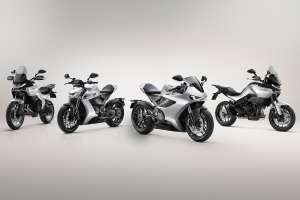
Norton Manx R
Following an earlier announcement that Norton was ending production of its current model range, the historic British brand debuted four new bikes at EICMA. According to Norton’s press release, these form part of the company’s “Resurgence strategy,” which has been in the works since TVS Motor Company purchased Norton five years ago.
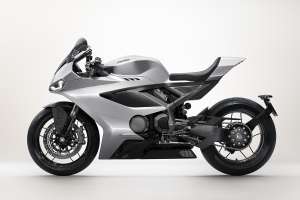
Norton revealed two dual-sport bikes—the Atlas and Atlas GT—along with the naked Manx roadster and fully-faired Manx R superbike. But of those four, it was the Norton Manx R that generated the most hullabaloo.
Punted as Norton’s new flagship model, the Manx R comes out the gate swinging. It’s powered by an all-new 72-degree 1,200 cc V4 engine, making 206 hp and 130 Nm of torque. The six-speed transmission is paired with a quick-shifter, while the cast chassis is matched to semi-active suspension, developed specifically for Norton by Marzocchi.

Norton describes the Manx R’s design language as “reductive design with artisanal engineering.” What that translates to is an incredibly sleek sportbike with a high-end feel. Note the single-sided swingarm, BST carbon fiber wheels, and Brembo Hypure front brake calipers. Also note the lack of any aero winglets; a welcome change from the current norm.
There’s a lot to digest, from the Manx R’s plethora of carbon parts to its comprehensive electronics package. But the big takeaway here is the balance of exclusivity and modernity that Norton has achieved. Could this be the motorcycle that pushes the previously embattled brand forward? [Norton]
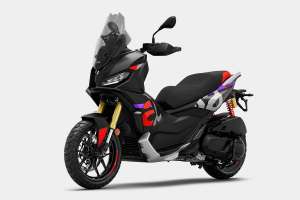
Aprilia SR GT 400
Aprilia is best known for its superbikes and presence in MotoGP, but the Italian marque has its fingers in a number of pies. Their latest offering, the Aprilia SR GT 400, belongs in a very specific niche—adventure scooters.
Positioned alongside Aprilia’s SR GT 125 and 200 scooters, the SR GT 400 boasts a 400 cc engine with 36 hp on offer, plus a new double-cradle steel frame, 120 mm of suspension travel at each end, and 190 mm of ground clearance. Its 16-inch front and 14-inch rear wheels are wrapped in Mitas Enduro Trail-ADV 2 tires—good for city riding with potential for regular gravel excursions.

Wide handlebars with OEM hand guards keep with the adventure bike theme, while a 12-liter [3.2-gallon] fuel tank promises a range of over 300 km [186 miles]. The Aprilia SR GT 400 also gets LED and a TFT dashboard, with a host of electronic rider aids, including a keyless ignition, and switchable traction control and ABS.
The SR GT 400 comes in four colors, but our pick is the Rally Replica livery shown here. Inspired by the Aprilia Tuareg Rally—a bike with two successive Africa Eco Race wins under its belt—it’s a bold design that suits this plucky adventure scoot perfectly. [Aprilia]

BSA Thunderbolt
BSA’s comeback continues with the revived British-born, Indian-owned company’s fourth new motorcycle—the new BSA Thunderbolt. Resembling the 1972 Thunderbolt in name only, this is BSA’s first-ever adventure bike, and it looks awesome.
A little digging reveals that the European industrial design studio Kiska handled the Thunderbolt’s new design—the same team that designs KTM and Husqvarna’s motorcycles. That’s an important note, because the Thunderbolt’s aesthetic is a radical departure from the modern classic theme that the rest of BSA’s current stable follows. In fact, there’s nothing retro about it.

Powered by a 334 cc single-cylinder engine, the Thunderbolt looks ready for business with a 15.5-liter fuel tank, 41 mm upside-down forks, 200 and 180 mm of travel front and back, and 21F/17R wheels. Modern amenities include a slip and assist clutch, a digital dash with Bluetooth connectivity and turn-by-turn navigation, and all the requisite rider aids.
The Thunderbolt’s styling is sharp as heck, and we’re particularly fond of the color-tinted windscreen and offset headlight design. Although pairing a big fuel tank with a small engine is somewhat puzzling, the new Thunderbolt hints at an exciting new direction for BSA. [BSA]
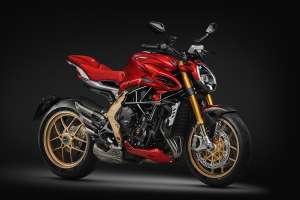
MV Agusta Brutale Serie Oro
Limited to 300 units, the MV Agusta Serie Oro is arguably MV Agusta’s most desirable naked bike yet. That’s because rather than tweak one of their existing Brutale models to create it, MV Agusta built the Serie Oro from the ground up.
It gets the company’s new 950 EVO engine—a 931 cc triple that kicks out 148 hp and 107 Nm, with 85% of its peak torque available at 3,500 rpm. The spec sheet includes a full Öhlins suspension package, Brembo’s top-of-the-line Hypure brake calipers at the front, and a titanium exhaust system from Termignoni. It rolls on lightweight forged wheels, wrapped in Pirelli Diablo Rosso IV tires.

On the tech side, the MV Agusta Brutale Serie Oro comes with a cornering LED headlight, a TFT display, and a full suite of electronic rider aids. But it’s the styling that really stands out. Resplendent in red, the Serie Oro wears sculpted bodywork, luxe upholstery, a hint of gold, and more carbon fiber than you can shake a stick at. [MV Agusta]
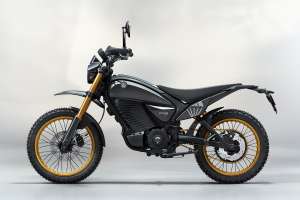
Flying Flea S6
Royal Enfield’s electric sub-brand, Flying Flea, debuted last year with the C6—a petite girder-forked bike inspired by the original World War II-era Royal Enfield Flying Flea. Now they’ve followed it up with the new, scrambler-styled Flying Flea S6.
The S6 trades the C6’s vintage styling and girder fork for a slightly more modernized dirt bike look, with an upside-down front fork and 19F/18R wheels. But the underlying architecture is the same, with a forged aluminum frame and elegant finned magnesium battery case. It also ditches the C6’s belt drive for a chain.
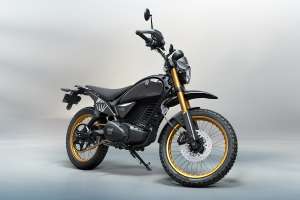
Equipped with a tall enduro-like seat, wide handlebars, and hand guards, the Flying Flea S6 is set up for commuting in the week and playing on the weekend. Royal Enfield lists several tech and connectivity features, but there’s no word on the S6’s top speed and range. That said, we’re not expecting it to be a high-speed, long-distance motorcycle.
Slated to launch late next year, the Flying Flea S6 could be just the thing for short-range shenanigans—just as long as it doesn’t price itself out of contention. [Flying Flea]

Zero LS1
While countless EV startups have come and gone, the American outfit Zero has stood the test of time. Present at EICMA this year, they unveiled a new offering to sit alongside their full-sized electric motorcycles: a scooter.
Designed in collaboration with Huge Design, the Zero LS1 is aimed squarely at riders in bustling European cities. Keywords are comfort and accessibility, with slick styling and a convenient battery design that uses two swappable units, stored in the scooter’s floor. There’s enough space under the seat to stash a helmet or to mount an optional third battery for even more range.
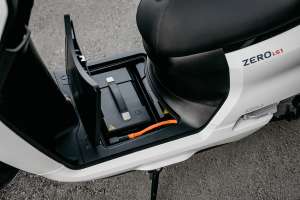
Zero claims a range of 115 km [72 miles] with two batteries, 170 km [106 miles] with three, and a top speed of 100 km/h [62 mph]. Because the batteries are removable, they can be swapped out and charged indoors. The 800W charger will get you to 95% capacity in 4.5 hours, while an optional 1500W fast charger brings that down to 2.75 hours.
We’re firm believers that electric drivetrains make the most sense in scooters, and the Zero LS1 reinforces that belief. If it hustles as well (and far) as Zero says it does, it’ll make for one heck of a slick commuter.
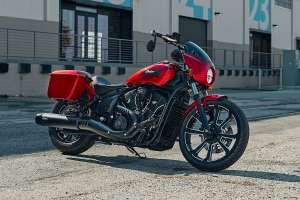
Indian Sport Scout RT and Sixty
The bulk of Indian Motorcycle’s EICMA-related news revolved around new paint options and accessories for 2026—and, of course, the reveal of the American marque’s jaw-dropping Girder Concept. But among the array of updates, two new models stood out: The Indian Sport Scout RT and Sport Scout Sixty.
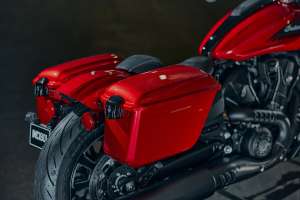
The new Sport Scout RT takes the West Coast performance style of the existing Sport Scout and dials it up a notch. For starters, its previously black fairing and fenders are now color-matched to the fuel tank, and the overall graphics package has been refreshed.
It also gets a pair of locking hard cases, with 37 liters of weatherproof storage. It sounds like a minor update, but when you combine those changes with the Sport Scout RT’s machined yokes, extended risers, and moto-style handlebars, you end up with a bike that feels like a nearly complete club-style custom, straight out of the box.
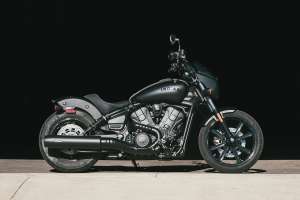
The new Indian Sport Scout Sixty goes in the opposite direction—stripping the Sport Scout’s default package back to offer a more affordable version. It still gets a quarter fairing up front, but the aggressive handlebar setup of the original Sport Scout gives way to a set of mini-ape bars with integrated risers. Finished off with a low solo seat and mid-mounted foot controls, it comes in matte black only. [Indian Motorcycle]


